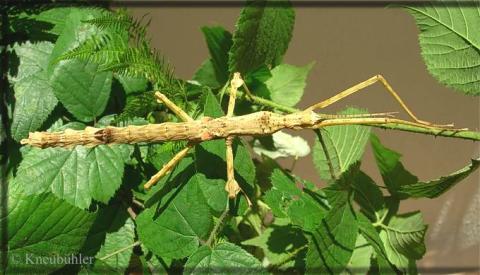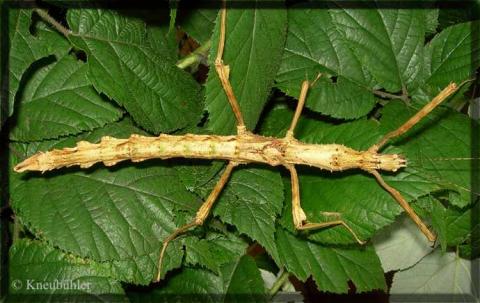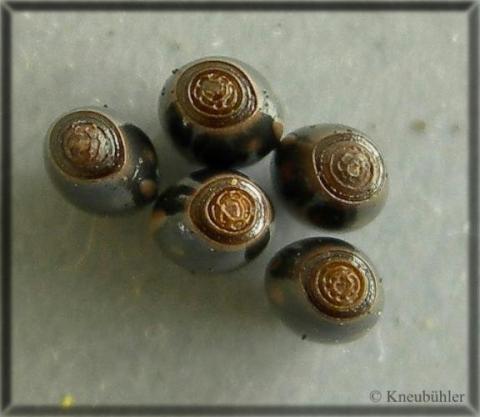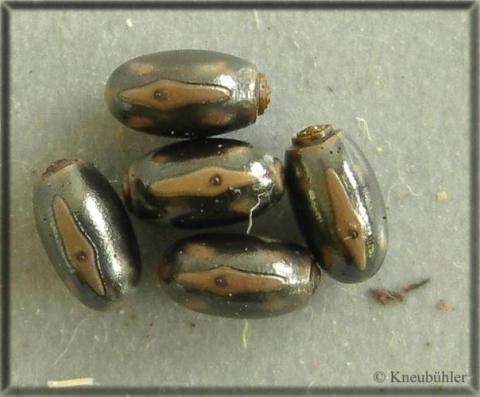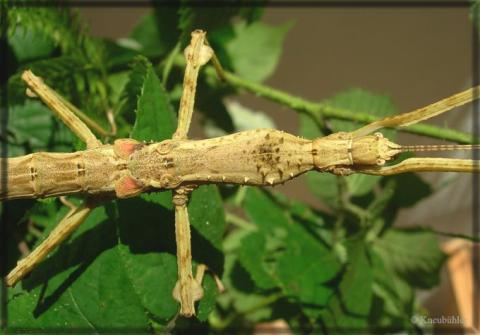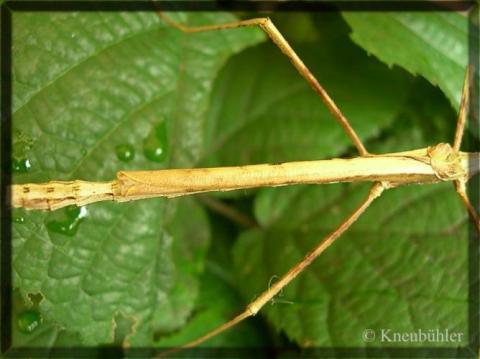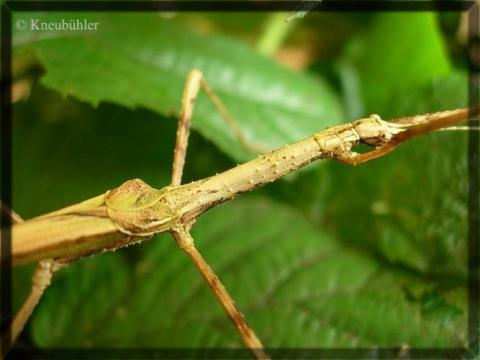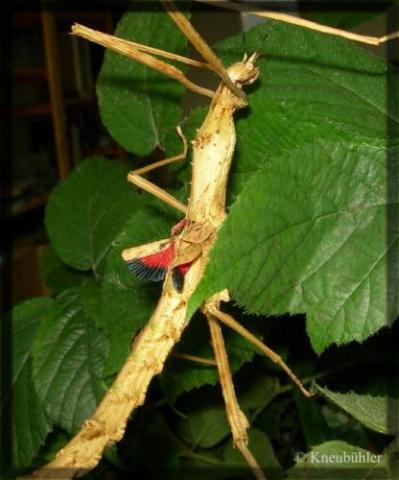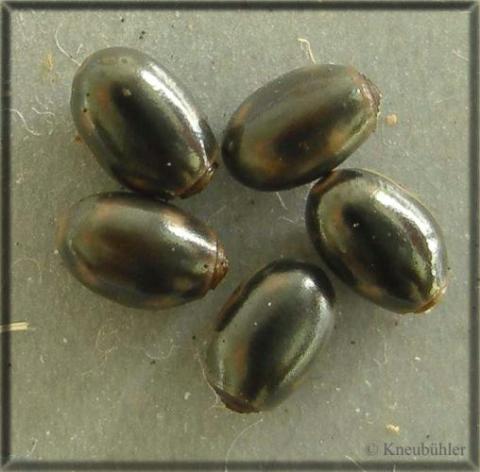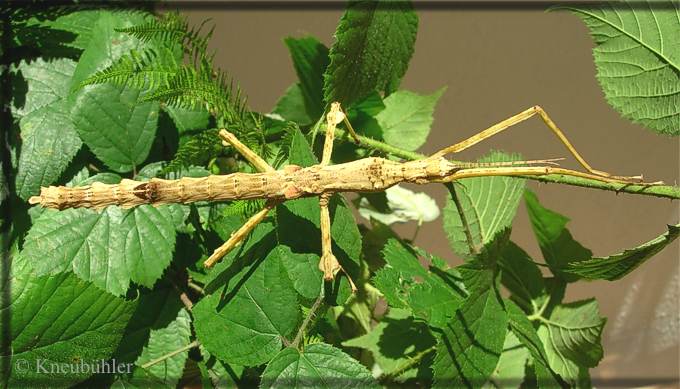
Genus
Species
Stock
CLP
216
PSG
300
Culture status
Probably lost
Foodplants
Bramble (Rubus spp.)
Breeding notes
(by Bruno Kneubuehler)
General Informations
- 2006 - first successful culture of this species by Bruno Kneubühler
- 2006 - I have distributed this species as Phasmotaenia spinosa to other breeders
_________________
Orgin
- Central Kwara'ae Province, Malaita Island (Solomon Islands)
- it seems to be quite a common species on Malaita
_________________
Females
- females are very variable in colour – mainly different shades of brown, giving them a bark like appearance
- occacionally there are green patches or even females of a predominatley green colour
- their length ranges between 13-15 cm, but some females can only be 10 cm long
- they have rudimentary wings
- the membranous area of the hind wings (aleae) can be displayed when they feel disturbed, thus showing their very beautifully colours - a bright red with a thick outer black band
- they do flash the hind wings when feeling disturbed, frequently when being handled
- forewings about 5-7 mm, hind wings about 9-11 mm
- they have a well developed subgenital plate, which is about 1 cm longer than the anal segment
- this subgenital plate is being use to fling eggs away
- there are distinct spines on the mesonotum, as well as on the lateral side of the metanotum and the femur of the middle and hind legs
- spines on the mesonotum are darker coloured
- antenneae are about 4 cm long, about 1 cm longer than the fore legs
- they have long legs with lobous expansion on the distal part of the middle and hind leg's femur
- an interesting characteristic of the females is that their thorax swells up when they have eaten. During the day the thorax then shrinks again. It seems that they are storing their food first in the area of the thorax
_________________
Males
- males are coloured in different shades of brown, sometimes with a faint greenish hue
- some dark brown spots all over the body
- their body lenght is about 9 cm
- hind wings are fully developed, reaching to the end of the 5th adominal segment
- thier membranous part is almost colourless and translucent
- they are able to fly and do sometimes quite unexpectedly
- forewings are very short (about 3-4mm)
- feelers are about 4 cm long
- males tend to react a bit less excited than the females when being handled
- on the mesonotum (espcially on its middle section), as well as on the side of the metanotum and the mid and hind legs femur, there are some distinct, yet small spines
- the spines on the mesonotum are darker coloured
_________________
Eggs
- dimensions: approximately 3,7 x 2,2 mm
- dark, almost black and glossy
_________________
Food Plants
- I feed mine mainly on bramble. In summer they also like raspberry and plum leaves. Hypericum has also been reported to me as being a food plant
- it might well be that they like also Salal (Gaultheria shallon), but I could not try this out
_________________
Breeding Notes
- nymphs hatch readily after about 3-4 months
- eggs of this species tend to go mouldy very easily. But this does notaffect the hatching ratio negatively
- hatching ratio can be as high as 70 - 90%
- eggs get significantly less mouldy if kept only on damp sand, together with a culture of spring tails
- the first generation was very difficult to upraise, as most nymphs would not start to feed. Only very few individuals got adult on bramble, oak and raspberry
- nymphs of the second generation took easily to bramble
- they grew up without further problem in an fairly airy cage, with a wet paper towel on the bottom to provide enough humidity
- Nymphs have particularly long legs already on hatching, so enough space for them is needed to avoid them getting crippled (especially when several nymphs hatch during the same night). Hatching takes place during the night.
- the adult females tend to be more difficult than the nymphs or the adult males. Some will stop feeding on bramble, although they started on this well after the final moult. If this happens, then try to feed them on other plants like raspberry, oak, plum leaves. Therefore this species is not so easy to be clutured !
- with some experience sexing of nymphs is easily possible by the second instar. In the 3rd instar many females will have more black/dark dots on their abdomen and prothorax and the females do develop a prolonged supraanal plate
- they reach adulthood after about 4 (males) to 5 months (females). As usual, males (having one moult less) mature earlier than females
- adults and nymphs can react very disturbed when being touched. So you must handle them very carefully
- females tend to get stressed when there are more males than females in the same cage. They might even stop feeding and starve to death. Therefore I keep the adult males seperate from the females. Males are only being put in the cage with the females for a few days - every two weeks or so. And I make shure that there are always less males as there are females in the same cage.
- After about 3-4 weeks females start to lay eggs – approximately 4-5 eggs a day
